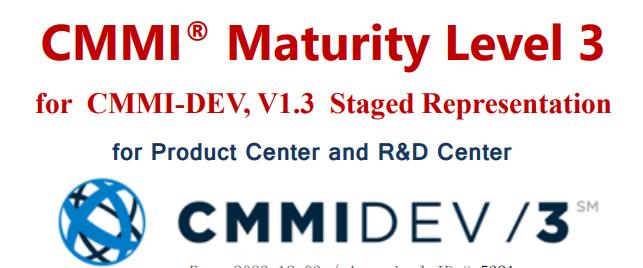
1: Background Introduction:
CMM (Capability Maturity Model) is the English abbreviation for 'Software Capability Maturity Model'. This model was commissioned by the Software Engineering Research Institute (SEI) of Carnegie Mellon University in the United States and developed in 1991 by the US Department of Defense. The initial main purpose was to evaluate the capabilities of software contracting organizations in the US Department of Defense. Later, it achieved significant success in improving the implementation process of CMM models in software enterprises, So it is widely used worldwide, and SEI also established the Chief Evaluator Evaluation System. In October 1997, the US Department of Defense ordered SEI to stop researching CMM and instead focus on developing CMMI (Capacity Maturity Model Integrated) to help businesses solve the problem of using multiple CMMs. SEI also announced that CMMI products will replace CMM. Therefore, on August 11, 2000, CMMI-SE/SW version 1.0 was issued, and version 1.1 was released in December 2001. The transition from CMM to CMMI began in 2003, and CMM was discontinued at the end of 2005. CMMI is a new version of CMM released by SEI in 2000. Currently, CMMI has developed to version 1.3 and only accepts evaluation results for version 1.3. CMMI currently includes three models, namely CMMI-DEV, CMMI-SVC, and CMMI-ACQ models.
CMMI-DEV: The latest version is the CMMI for Acquisition v1.3 released by SEI in November 2010. This version integrates three major disciplines: software engineering, hardware engineering, and system engineering.
The CMMI model divides maturity into five levels in a phased expression: 1- Initial level; 2- Managed level; 3- Defined level; 4- Quantitatively managed; 5- Continuous optimization level;

2: The Benefits of Implementing CMM/CMMI
It can help IT enterprises manage and improve software/system engineering processes, enhance development and improvement capabilities, and enable high-quality software and system integration projects to be developed on time and within budget, improve the management level of the enterprise, and enhance international competition. Specifically reflected in the following aspects:
(1) To ensure the quality and progress of software development, and to standardize the 'disorderly and disorderly management' project development process.
(2) Beneficial for cost control, as quality is guaranteed, the cost of waste in modifying and resolving customer complaints will be reduced. Nowadays, the vast majority of enterprises lack standardized systems and only seek speed. After the project is completed, it takes a lot of time to repair, and the cost can easily get out of control.
(3) Helps improve the professional literacy of software developers. The working methods of every employee involved, whether it is a project manager, engineer, or even some senior managers, have gradually become standardized and standardized.
(4) Can solve the problems caused by personnel mobility. The company establishes a shared database through process improvement, rather than relying solely on certain personnel.
(5) It is conducive to improving the performance management level of the company and employees, and continuously improving their efficiency. Establish efficiency indicators for the company by measuring and analyzing the development process and products.
3: CMM/CMMI Standard Features
The idea of CMM/CMMI comes from the long-standing product quality management and total quality management. The software capability maturity model incorporates the concept of comprehensive quality management, reflecting the basic principles of project management and project engineering in software process quantitative control at an evolving level. The idea behind CMM/CMMI is that by continuously managing and improving the infrastructure and practices of enterprise engineering processes, difficulties in software and hardware production can be overcome, development and manufacturing capabilities can be enhanced, and high-quality software products can be manufactured on time and within budget.

4: Basic conditions for implementing CMM/CMMI:
(a) Assessor requirements: The CMM/CMMI evaluation must be conducted by a chief evaluator authorized by SEI, and comply with the evaluation requirements (ARC) and evaluation method SCAMPI issued by SEI;
(b) For CMM/CMMI evaluation, it is generally required that the project or product activity of the enterprise should be able to cover the requirements of the applied CMM/CMMI level.
5: Implement the CMM/CMMI consultation and evaluation process
--Basic training
--Diagnostic planning and gap analysis
--Establish SEPG Group
--Establishing documents and training
--Project tracking pilot
--Promote and institutionalize
--Pre evaluation
--Trial evaluation
--Certificate issuance
--SEI official website login
--Continuous improvement
Common issues with CMMI certification?
1. Q: What information is displayed on the certificate?
A: Mainly including certificate number, company name, company certification scale (small, medium, large), business scope, certificate validity period, and name of issuing institution.
2. Q: Which departments are involved in CMMI certification?
A: R&D and Administration departments.
3. Q: How long is the CMMI certification cycle?
A: According to the level, it varies from 2 months to 5 months.
4. Q: How long is the certificate valid?
A: Three years, re evaluated or upgraded after expiration, without the need for annual supervision and review.
What materials need to be prepared for CMMI certification
1. Enterprise Business License
2. Application Form
3. Organizational Chart
CMMI certification process
-Information collection
-Evaluation Plan
-Online registration
-Prepare for reading check
-Formal evaluation
-Official audit
-Official website release:( https://sas.cmmiinstitute.com/pars/pars.aspx )Publish enterprise level information on the website
